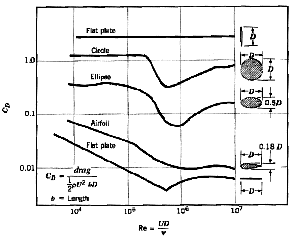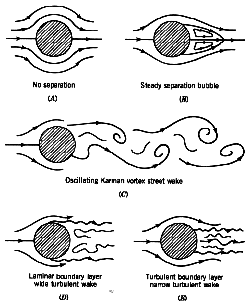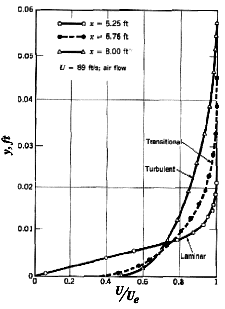|
|
 |
11. Drag of Blunt and Streamlined Bodies
A body moving through a fluid experiences a drag force, which is usually divided into
two components: frictional drag, and pressure drag. Frictional drag
comes from friction between the fluid and the surfaces over which it is flowing. This
friction is associated with the development of boundary layers, and it scales with
Reynolds number as we have seen above. Pressure drag comes from the eddying motions
that are set up in the fluid by the passage of the body. This drag is associated with
the formation of a wake, which can be readily seen behind a passing boat, and it is
usually less sensitive to Reynolds number than the frictional drag. Formally, both types
of drag are due to viscosity (if the body was moving through an an inviscid fluid there
would be no drag at all), but the distinction is useful because the two types of drag
are due to different flow phenomena. Frictional drag is important for attached
flows (that is, there is no separation), and it is related to the surface area
exposed to the flow. Pressure drag is important for separated flows, and it is related
to the cross-sectional area of the body.
We can see the role played by friction drag (sometimes called viscous drag) and
pressure drag (sometimes called form drag or profile drag) by considering
an airfoil at different angles of attack. At small angles of attack, the boundary layers
on the top and bottom surface experience only mild pressure gradients, and they remain
attached along almost the entire chord length. The wake is very small, and the drag is
dominated by the viscous friction inside the boundary layers. However, as the angle of
attack increases, the pressure gradients on the airfoil increase in magnitude. In
particular, the adverse pressure gradient on the top rear portion of the airfoil may
become sufficiently strong to produce a separated flow. This separation will
increase the size of the wake, and the pressure losses in the wake due to eddy
formation Therefore the pressure drag increases. At a higher angle of attack, a
large fraction of the flow over the
top surface of the airfoil may be separated, and the airfoil is said to be stalled. At
this stage, the pressure drag is much greater than the viscous drag
.
When the drag is dominated by viscous drag, we say the body is streamlined, and when
it is dominated by pressure drag, we say the body is bluff. Whether the
flow is viscous-drag dominated or pressure-drag dominated depends entirely on the shape
of the body. A streamlined body
looks like a fish, or an airfoil at small angles of attack, whereas a bluff body looks
like a brick, a cylinder, or an airfoil at large angles of attack. For streamlined
bodies, frictional drag is the dominant source of air resistance. For a bluff body,
the dominant source of drag is pressure drag. For a given
frontal area and velocity, a streamlined body will always have a lower resistance than
a bluff body. For example, the drag of a cylinder of diameter D can be ten times larger
than a streamlined shape with the same thickness (see figure 11.1).
 |
 |
Figure 11.1 Drag coefficients of blunt and streamlined bodies.
From Munson, Young and Okiishi, Fundamentals of Fluid Mechanics, John Wiley & Sons, 1998.
|
Cylinders and spheres are considered bluff bodies because at large Reynolds numbers
the drag is dominated by the pressure losses in the wake. The variation of the drag
coefficient with Reynolds number is shown in figure 11.2, and the
corresponding flow patterns are shown in figure 11.3.
We see that as the
Reynolds number increases the variation in the drag coefficient (based on cross-sectional
area) decreases, and over a large range in Reynolds number it is nearly constant.
 |
 |
Figure 11.2 Drag coefficient as a function of Reynolds
number for smooth circular cylinders and smooth spheres.
From Munson, Young and Okiishi, Fundamentals of Fluid Mechanics, John Wiley & Sons, 1998.
|
 |
 |
Figure 11.3 Flow patterns for flow over a cylinder: (A) Reynolds
number = 0.2; (B) 12; (C) 120; (D) 30,000; (E) 500,000. Patterns correspond to the
points marked on figure 11.2. From Munson, Young and Okiishi, Fundamentals of Fluid Mechanics, John Wiley & Sons, 1998.
|
At a Reynolds number between 10^5 and 10^6, the drag coefficient takes a sudden
dip. The size of the wake decreases, indicating that the boundary layer separation on
the cylinder or sphere occurs further along the surface than before. What has happened?
The phenomenon is related to the differences between laminar and turbulent boundary
layer. The boundary layer and its
interaction with the local pressure gradient plays a major role in affecting the
flow over a cylinder.
In particular, near the shoulder, the pressure gradient changes from being
negative (decreasing pressure) to positive (increasing pressure). The force
due to pressure differences changes sign from being an accelerating force to being a
retarding force. In response, the flow slows down. However, the fluid in the
boundary layer has already given up some
momentum because of viscous losses and viscous friction, and it
does not have enough momentum to overcome the retarding force. Some fluid near the
wall actually reverses direction, and the flow separates.
A laminar boundary layer has less momentum near the wall than a turbulent boundary layer, as shown in figure 11.4, because turbulence is a very effective mixing process.
More importantly, turbulent transport of momentum is very effective at replenishing the
near-wall momentum.
So when a turbulent boundary layer enters a region of adverse
pressure gradient, it can persist for a longer distance without separating (compared to
a laminar flow) because the momentum near the wall is higher to begin with, and it is
continually (and quickly) being replenished by turbulent mixing .
 |
 |
Figure 11.4 Boundary layer profiles for laminar and turbulent flow.
From Schlichting, Boundary Layer Theory, 7th ed., McGraw-Hill, 1979.
|
The boundary layer over the front face of a sphere or cylinder is laminar
at lower Reynolds numbers, and turbulent at higher Reynolds numbers. When it is
laminar (Re < 10^5), separation starts almost as soon as the pressure gradient
becomes adverse (very near the shoulder, figure 11.3D), and a large
wake forms. When it is turbulent (Re > 10^6), separation is delayed (to a point
about
20^o past the shoulder, figure 11.3E) and the wake is
correspondingly smaller.
It follows that, if the boundary layer of a sphere can be made turbulent at a lower
Reynolds number, then the drag should also go down at that Reynolds number. This is the
case, as we can show by using a trip wire. A trip wire is simply a wire located on the
front face of the sphere and it introduces a large disturbance into the boundary layer.
This disturbance causes an early transition to turbulence, and it effect on the size of
the wake, and the total drag is quite dramatic, as shown in figure 11.5.
 |
 |
Figure 11.5 Flow over a sphere:
(a) Reynolds number = 15,000; (b) Reynolds number = 30,000, with trip
wire. From Werlé, ONERA, 1980.
|
|
 |